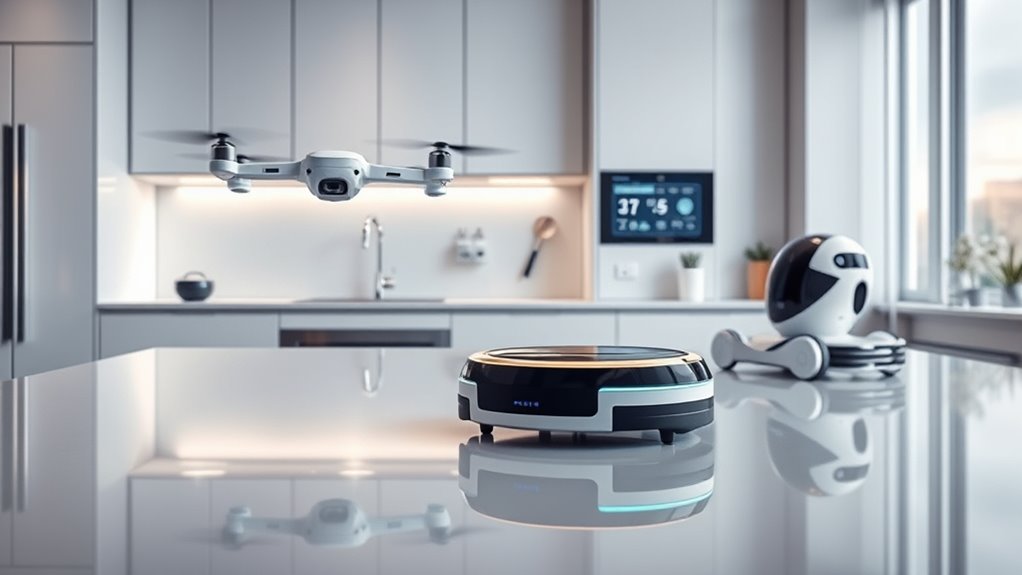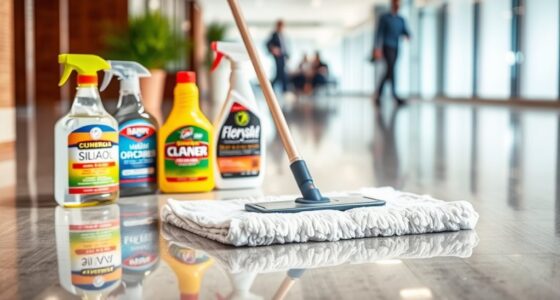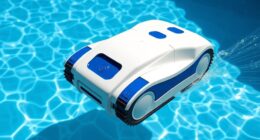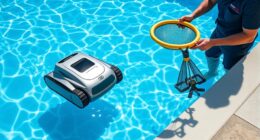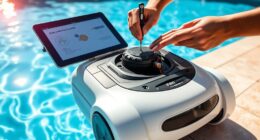The future of cleaning is exciting, with AI and automation revolutionizing the way you maintain your home. Smart cleaning robots are becoming essential, adapting their methods based on real-time needs. You’ll find increasing demand for eco-friendly products that prioritize health and sustainability. Innovations like automated communication tools enhance customer engagement. As these trends evolve, they promise to create a cleaner, more efficient environment for you. Discover how these advancements will reshape your cleaning routines even further.
Key Takeaways
- AI-powered cleaning robots will automate repetitive tasks, enhancing operational efficiency and reducing labor costs for cleaning services.
- Real-time monitoring and data analytics will enable precise tracking of cleanliness and resource usage, optimizing cleaning operations.
- Sustainable practices will dominate the industry, integrating eco-friendly products and technologies to meet evolving consumer expectations.
- Automated communication tools, such as chatbots, will improve client engagement by providing instant responses and real-time updates on services.
- Feedback mechanisms will facilitate continuous improvement in service quality by incorporating client insights into cleaning operations.
Smart Cleaning and AI-Powered Automation
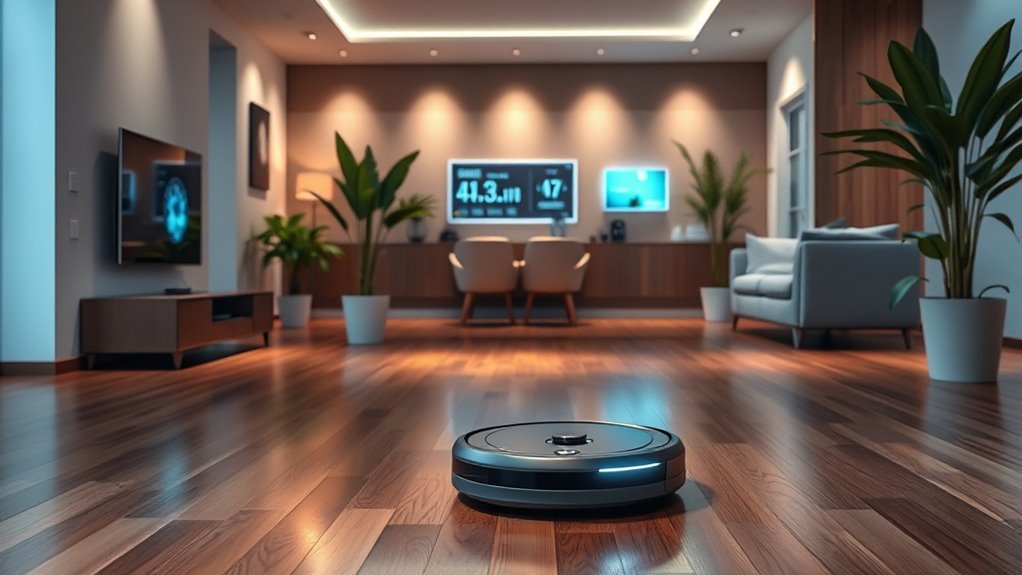
Smart cleaning and AI-powered automation are revolutionizing how we manage our homes.
Imagine having cleaning robots that tackle daily chores and even assist with cooking, all while enhancing operational efficiency. These advanced systems not only streamline your home management but also incorporate predictive maintenance, ensuring your devices operate at their best. Additionally, maintaining air purifiers effectively can enhance overall indoor air quality, contributing to a healthier living environment. Regular filter replacement in air purifiers is crucial for optimal performance and longevity. Robot vacuums with advanced sensors improve navigation and efficiency, making them indispensable in modern homes.
Envision a home where cleaning robots handle daily tasks and cooking, optimizing efficiency through advanced predictive maintenance.
With innovations like AI-adaptive technologies and human washing machines utilizing water jets, you’re witnessing a shift toward cost-effective cleaning solutions that prioritize hygiene.
Plus, emotional analysis integration aims to provide psychological benefits alongside physical cleanliness. Furthermore, the integration of high refresh rates in smart home devices can enhance the overall user experience by providing seamless interactions.
Embracing smart cleaning and AI-powered automation means investing in a future where your home isn’t only cleaner but also smarter, making life easier and more enjoyable for you.
Changing Consumer Preferences in Home Hygiene
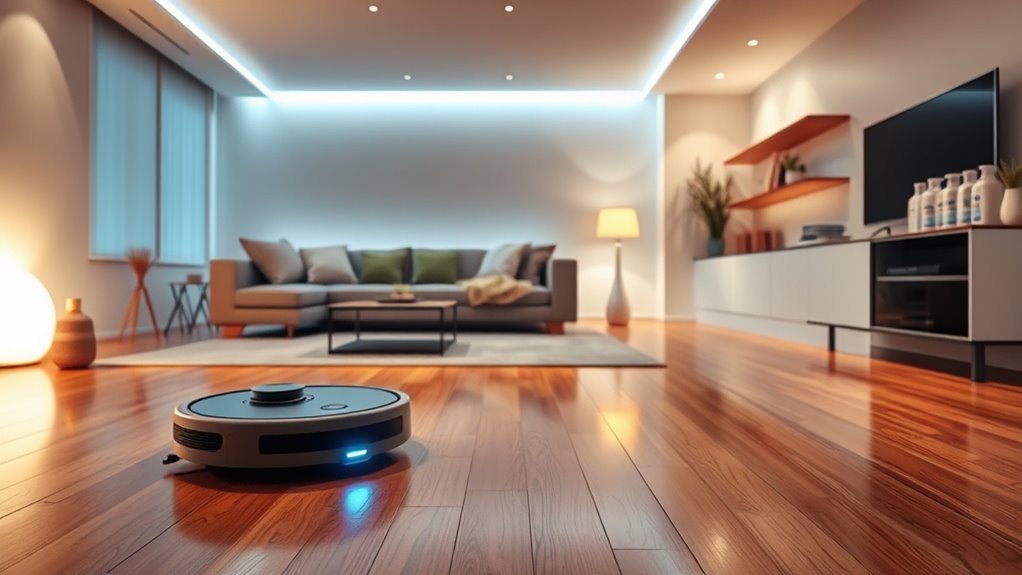
As consumers increasingly prioritize their well-being, they’re redefining what cleanliness means in their homes.
You’re likely noticing a shift in consumer preferences toward more inviting and comforting environments.
Here are some key trends:
- Preference for natural aromas like lavender and citrus over harsh bleach scents.
- Increased demand for eco-friendly cleaning products that promote health and safety.
- A focus on cleaning solutions that enhance sensory experiences rather than just sterility. Essential oils can enhance the effectiveness of traditional cleaning agents.
- Rising popularity of biodegradable, non-toxic, and refillable cleaning products. Additionally, the trend toward home security systems reflects a growing concern for overall safety, which complements consumers’ desires for a peaceful living environment.
These changes reflect a desire for a pleasant home atmosphere, similar to the way beekeepers manage bee populations to ensure a healthy ecosystem. Additionally, the trend toward wood-burning stoves as a sustainable heating option enhances the comfort of living spaces, aligning with consumers’ preferences for cozy environments.
Brands are responding by developing cleaning products that not only effectively clean but also contribute to your overall well-being and comfort.
Sustainability and Health-Driven Innovations
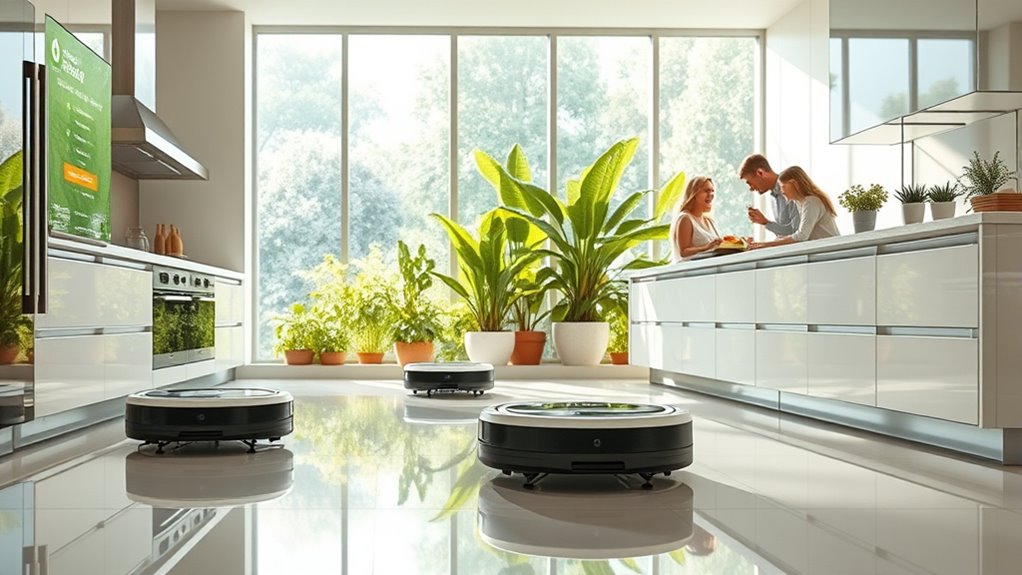
As you look for cleaning solutions, you’ll notice a strong push towards eco-friendly products that prioritize not just cleanliness, but also your health and indoor air quality. Companies are integrating sustainable practices to meet your evolving expectations and reduce their environmental impact. Additionally, many brands are now focusing on smart home integration to enhance user experience and convenience in cleaning routines. This includes utilizing energy efficiency measures that can help lower overall utility costs while maintaining a clean home. Furthermore, employing energy monitoring features allows consumers to track and optimize their energy usage during cleaning tasks. The trend towards renewable resources in heating, such as wood stoves, highlights the growing importance of sustainability in all aspects of home management.
Eco-Friendly Cleaning Solutions
How can eco-friendly cleaning solutions transform your home while protecting the planet? By embracing sustainable hygiene practices, you can create a healthier environment for yourself and future generations.
Here are four key benefits:
- Biodegradable cleaning products break down naturally, reducing waste in landfills. Additionally, the trend towards using sustainable materials in household products emphasizes the importance of making environmentally conscious choices. Implementing the art of decluttering can also enhance the overall sustainability of your living space. Furthermore, the incorporation of renewable energy sources in the production of cleaning products helps decrease the carbon footprint associated with manufacturing.
- Non-toxic cleaning options minimize harmful chemicals, ensuring a safer home for your family.
- The rise of environmental consciousness means more brands are prioritizing eco-friendly certifications like Green Seal and EPA’s Safer Choice.
- Companies are adopting closed-loop systems, promoting the reuse and recycling of products and packaging.
Additionally, using air purifiers can significantly enhance indoor air quality, further supporting a healthy living environment.
With these innovations, you’re not just cleaning your home; you’re contributing to a cleaner, greener planet.
Indoor Air Quality Focus
With indoor air quality (IAQ) becoming a critical focus for cleaning services, particularly in spaces like offices and healthcare facilities, you’re likely to see significant changes in how cleanliness is approached.
Companies are now integrating advanced cleaning technologies that prioritize IAQ, employing real-time monitoring systems to track and reduce airborne illnesses. Additionally, many cleaning services are beginning to incorporate essential oil safety practices by using non-toxic and natural aromatherapy oils to improve air quality without compromising health. This shift towards sustainable practices not only benefits indoor environments but also aligns with a growing demand for eco-friendly solutions. Furthermore, the adoption of solar energy solutions can provide sustainable power for cleaning equipment, further enhancing operational efficiency.
By 2025, the market will lean heavily towards eco-friendly cleaning solutions that not only enhance IAQ but also support sustainability efforts.
You’ll notice a growing commitment to using biodegradable and non-toxic products, along with closed-loop systems for product recycling.
As a result, certification in green and IAQ standards will become essential, ensuring that cleaning services meet the rising demand from eco-conscious customers while complying with health regulations.
Furthermore, solar energy solutions can be integrated into cleaning operations to power equipment sustainably, further enhancing their environmental credentials.
Sustainable Practices Integration
The focus on indoor air quality naturally leads to the integration of sustainable practices within the cleaning industry.
As you embrace these changes, consider the following advancements:
- Eco-friendly cleaning solutions: By 2025, biodegradable and non-toxic products will be market standards. These solutions are often high in antioxidants, which can help to improve indoor air quality, contributing to reduced chronic disease risk. Additionally, the use of airless paint sprayers for projects can minimize harmful emissions during painting tasks.
- Automated cleaning: Incorporating low-water and energy-efficient methods will lessen your environmental impact.
- Closed-loop systems: These systems for product and packaging reuse will greatly reduce waste.
- Green certifications: Obtaining these standards will help attract eco-conscious customers, boosting your competitiveness.
Additionally, implementing budget-friendly home appliance maintenance plans can further enhance sustainability by ensuring appliances operate efficiently and last longer.
The Human Element in Cleaning Services
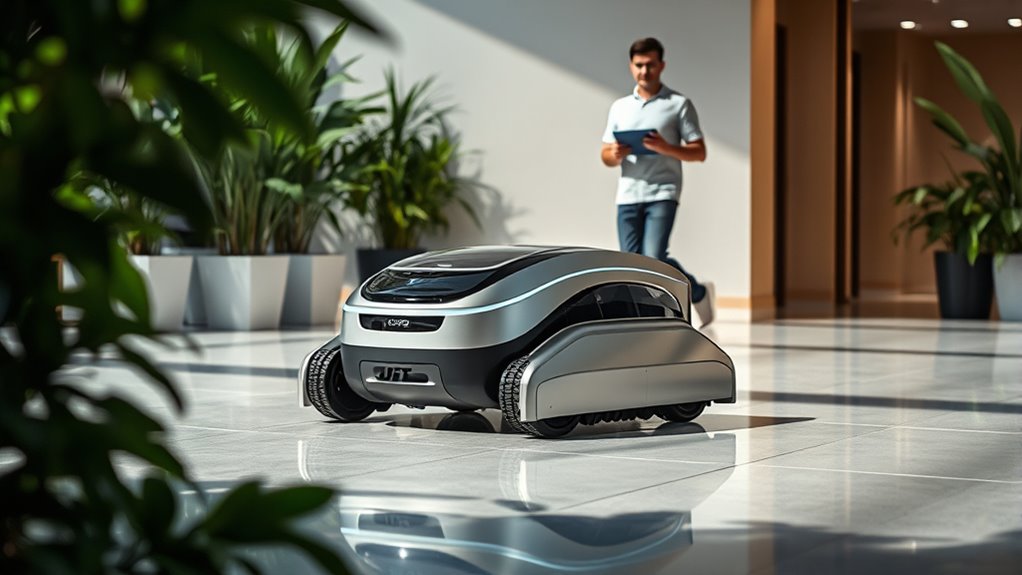
In today’s cleaning industry, a balance between automation and human expertise is necessary. While AI and automation enhance efficiency, the human element remains essential. Skilled professionals bring judgment, empathy, and personal interaction to cleaning services—qualities machines can’t replicate. A focus on training and fair compensation is imperative for recognizing cleaners as frontline workers in health and safety. Improved wages can boost job satisfaction and service quality, fostering positive client relationships. Additionally, investing in self-care routines for cleaning staff can further enhance their well-being and overall performance. Creating accessible living spaces can also improve the working environment for cleaners, leading to greater job satisfaction. Engaging in mindfulness practices can also help cleaning staff reduce stress and maintain focus during their tasks.
| Human Element | Automation |
|---|---|
| Empathy | Efficiency |
| Complex problem-solving | Routine tasks |
| Personal interaction | Data analysis |
| Relationship building | Performance tracking |
The future of cleaning relies on this harmonious blend for ideal service delivery.
The Role of Robotics in Modern Cleaning
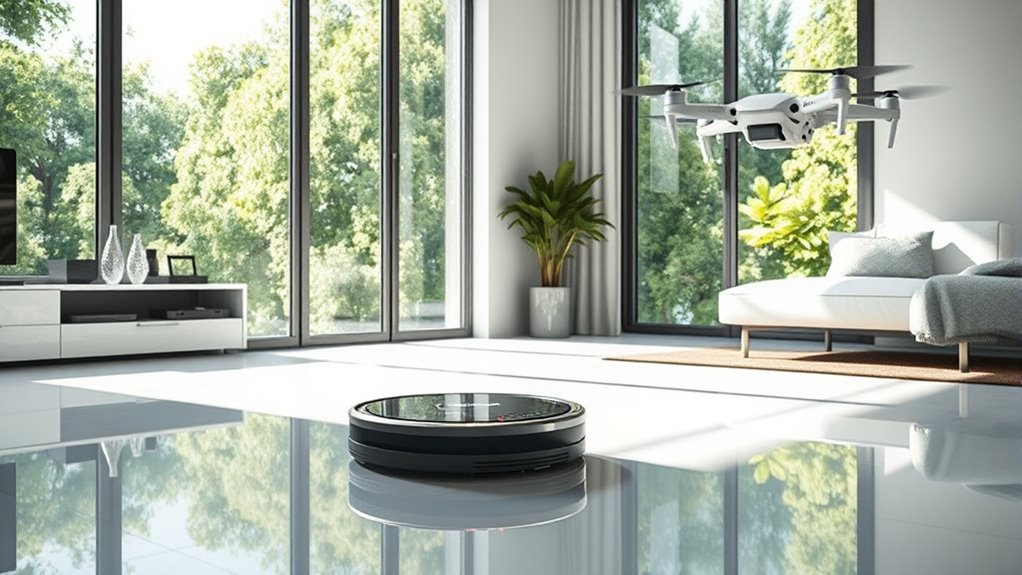
As cleaning demands evolve, robotics plays an increasingly essential role in enhancing efficiency and effectiveness.
You’ll find that cleaning robots are revolutionizing the commercial cleaning industry in several ways:
- Automated machines like robotic vacuums and scrubbers lower labor costs by taking on routine tasks.
- AI-powered autonomous robots adapt their cleaning patterns based on real-time dirtiness levels, optimizing their routes.
- Advanced sensors and mapping technologies in commercial-grade vacuums guarantee high sanitation standards in large spaces, such as airports and hospitals.
- Drones tackle hard-to-reach areas, showcasing the versatility of robotics in modern cleaning applications.
These innovations not only improve efficiency but also pave the way for advanced cleaning techniques that redefine how we maintain our environments.
Data-Driven Decision Making in Cleaning Operations
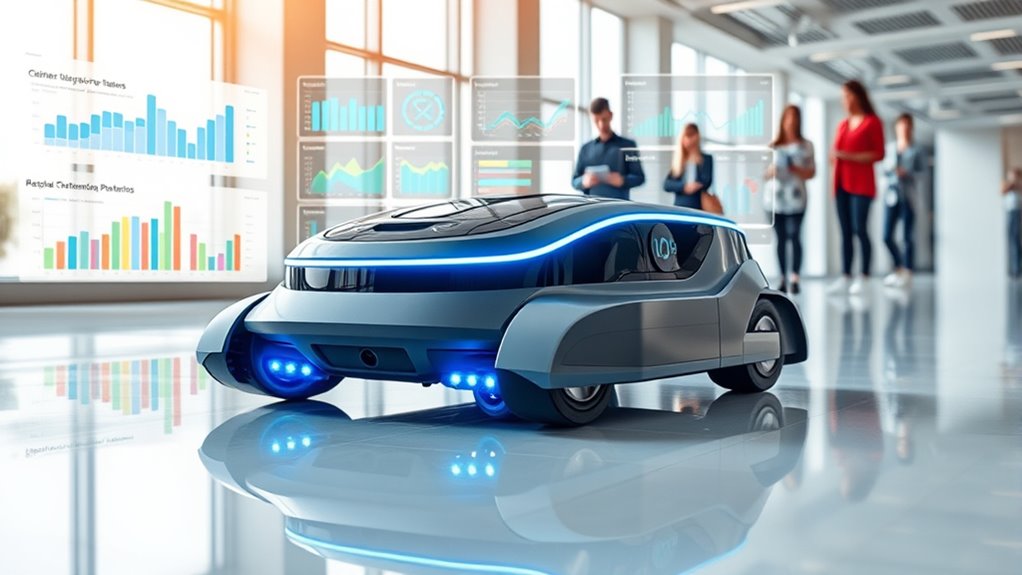
While many cleaning operations still rely on traditional methods, incorporating data-driven decision-making can greatly enhance efficiency and service quality.
By leveraging AI-powered software, you can access real-time monitoring of cleaning performance metrics, allowing you to make immediate adjustments when needed.
Utilizing data analytics helps you identify patterns in client preferences, leading to more customized and effective cleaning plans.
Harnessing data analytics enables the recognition of client preferences, paving the way for tailored and impactful cleaning solutions.
Smart sensors and IoT devices facilitate continuous data collection, providing actionable insights for optimizing cleaning processes and minimizing waste.
Ultimately, embracing data-driven strategies boosts productivity and customer satisfaction, giving your cleaning services a competitive edge in the market.
Innovations in Cleaning Techniques and Technologies
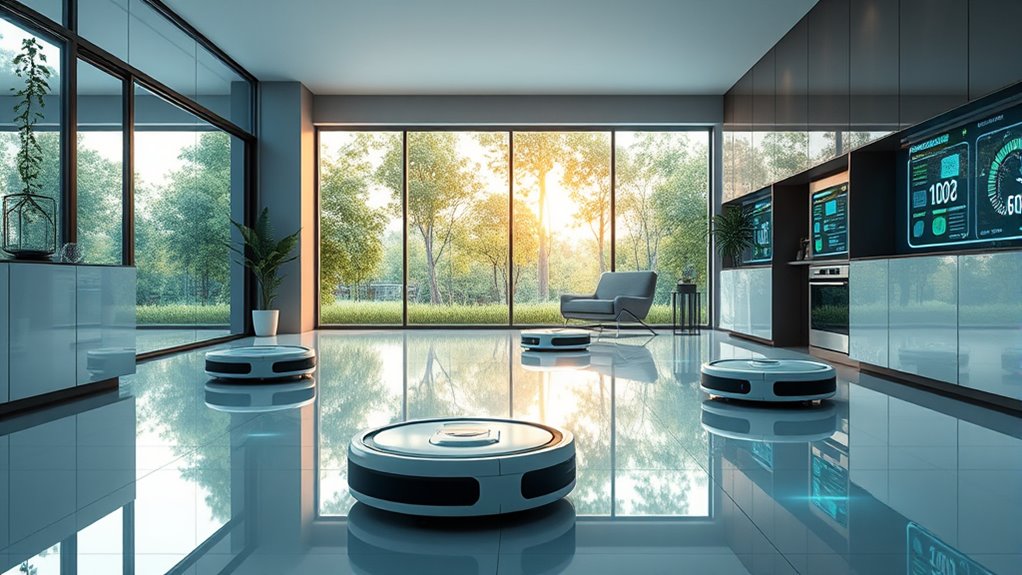
Innovations in cleaning techniques and technologies are transforming how you maintain spaces, making processes more efficient and effective. Here are some cutting-edge advancements:
- AI-powered cleaning robots use advanced navigation to optimize their cleaning patterns, easily tackling obstacles.
- Innovative cleaning techniques, like UV-C disinfection, enhance sanitation in public spaces by eliminating microorganisms.
- Deep cleaning capabilities in modern devices allow seamless shifts between vacuuming and mopping for thorough cleaning on various floor types.
- Machine learning algorithms enable cleaning equipment to adapt in real-time based on dirtiness levels, ensuring targeted efforts.
With IoT-enabled devices, you can monitor cleaning needs in real-time, enhancing resource management and sustainability in your cleaning operations.
Embrace these innovations for a cleaner future!
Economic Impacts of AI Integration in Cleaning

The integration of AI technologies in cleaning services not only streamlines operations but also considerably impacts your bottom line. By adopting AI-driven solutions, you can experience significant cost savings, reduced labor costs, and improved operational efficiency.
These enhancements lead to higher profit margins and better service quality, making it easier to retain clients. While initial investments in AI devices and staff training might seem challenging, the long-term benefits, such as a 30% increase in operational efficiency, often outweigh these costs.
Predictive analytics further allows you to anticipate needs and allocate resources effectively, boosting productivity. Ultimately, cleaning companies that leverage AI technologies not only enhance client satisfaction but also position themselves for sustained financial success in a competitive market.
Future Trends in Cleaning Service Delivery
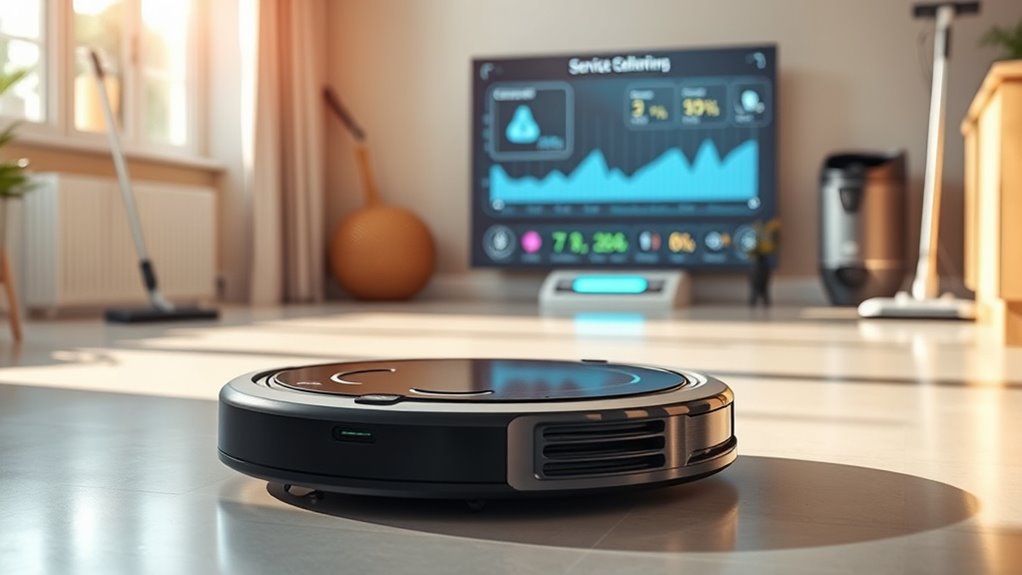
As the cleaning service industry evolves, you’ll likely see a surge in AI-powered solutions that transform how services are delivered.
Here are some future trends to watch for:
- AI-driven cleaning robots will take over repetitive tasks, boosting operational efficiency and reducing labor costs.
- Automation will streamline workflows, allowing for quicker response times and less human error.
- Real-time monitoring through IoT technology will enable you to track cleanliness and resource usage, making data-driven adjustments seamless.
- Companies will focus on sustainable practices, integrating eco-friendly products and UV-C disinfection to meet rising hygiene expectations.
These trends won’t only enhance service delivery but also guarantee you stay ahead in the evolving cleaning landscape.
Enhancing Customer Engagement Through Technology
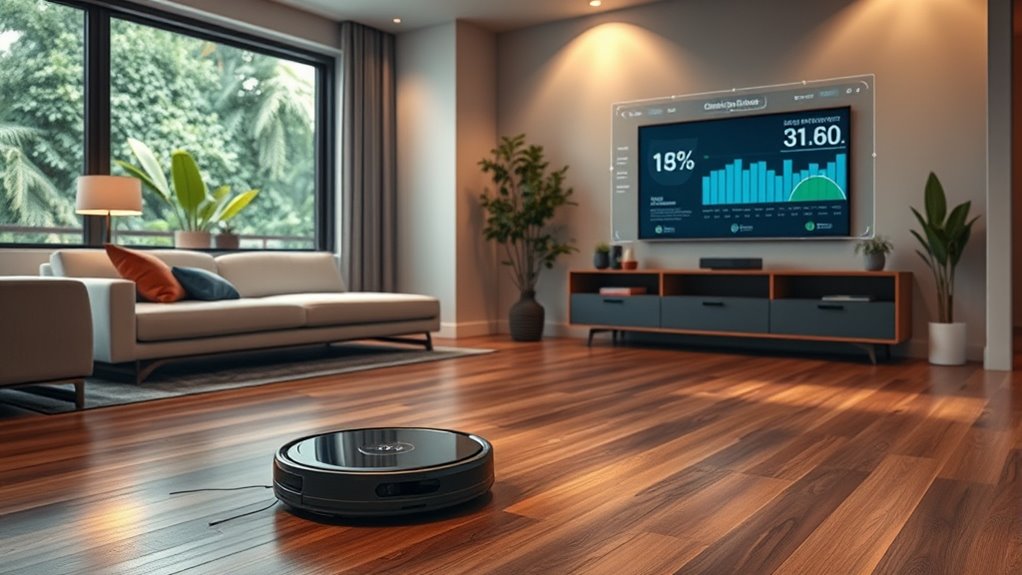
While cleaning services traditionally relied on manual processes, technology now offers powerful tools to enhance customer engagement.
For cleaning businesses, AI-driven client service platforms greatly improve response times by 25%, boosting client satisfaction and retention. Automated communication tools, like chatbots, keep you updated on service schedules and promotions, ensuring you never miss important information.
Additionally, feedback mechanisms integrated into cleaning service software allow for real-time input, enabling businesses to adapt their offerings based on your preferences. Seasonal promotional strategies powered by data analytics target specific customer segments, increasing engagement during peak times like spring cleaning or post-holiday periods.
Frequently Asked Questions
What Is the Future of the Cleaning Industry?
The future of the cleaning industry looks promising.
You’ll see significant growth in AI-powered cleaning solutions, which will enhance efficiency and effectiveness in your cleaning routines.
Eco-friendly practices will become standard, aligning with your values for sustainability.
As automation increases, the role of cleaning professionals will shift, requiring you to adapt and upskill.
Will AI Replace Cleaners?
Did you know that robotic cleaners can boost operational efficiency by up to 30%?
While AI and automation are becoming more common in cleaning, they won’t fully replace human cleaners. You’ll still need skilled workers to handle complex tasks and interact with customers.
AI can take over repetitive jobs, letting you focus on higher-value activities. The human touch remains essential, ensuring quality control and providing the oversight that robots simply can’t replicate.
How Is AI Used in Cleaning?
AI’s used in cleaning through various innovative technologies.
You’ll find robotic cleaners that analyze their surroundings, optimizing cleaning patterns for faster results.
Predictive maintenance tools monitor equipment in real-time, helping you avoid downtime with timely repairs.
AI-driven scheduling systems efficiently allocate resources based on data, enhancing task management.
Plus, smart sensors provide real-time cleanliness levels, allowing you to adjust cleaning strategies and improve customer satisfaction effectively.
What Is the Future of AI in 2025?
By 2025, the AI landscape will be buzzing with innovation, as the cleaning robot industry is projected to hit USD 12.9 billion.
You’ll see machine learning algorithms optimizing cleaning schedules in real-time, making operations more efficient. IoT devices will monitor cleanliness levels, providing you with valuable insights.
With AI-powered cleaners tackling complex tasks, you’ll notice a significant drop in manual labor reliance, leading to enhanced cleaning quality and reliability.
Conclusion
As the saying goes, “There’s no place like home,” and keeping it clean has never been more innovative. Embracing AI and automation revolutionizes how you think about hygiene, making it smarter and more efficient. With evolving consumer preferences and a focus on sustainability, the future of cleaning looks bright. By integrating these technologies, you can enhance your cleaning experience while also staying eco-friendly. It’s time to welcome a cleaner, more automated future into your home!

